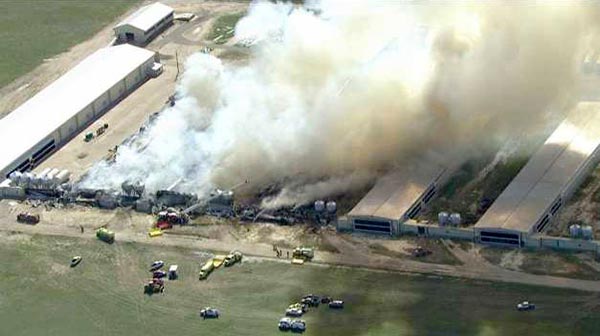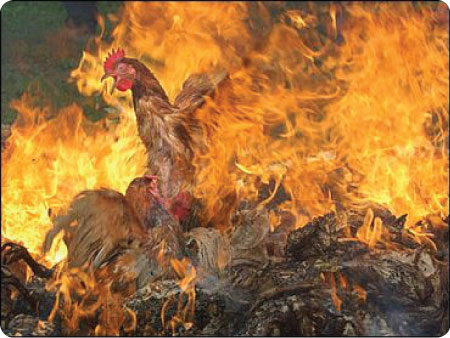In June 2012, the National Fire Protection Association, “the authority on fire, electrical, and building safety,” based in Quincy, MA, passed a
floor amendment by a two thirds vote (126 yes to 46 no) recommending that all newly constructed farm animal housing facilities in the United States be
equipped with fire protection sprinklers and smoke control systems. With nearly one billion farmed animals confined in U.S. facilities on any given day,
the risk of fire-related tragedies is huge. Between March and July alone this year, 535,000 animals, the majority of them chickens and turkeys as well as
thousands of pigs and more than 100 dairy cows and calves, burned and suffocated to death in facility fires, unable to escape their prisons. And these are
just the reported cases.
-
July 2012: 2,500 pigs and one building destroyed in Kansas
- June 2012: 17,000 chickens and one building destroyed in Nevada
- June 2012: 7,000 turkeys and one building destroyed in North Carolina
- June 2012: 7,000 turkeys and two buildings destroyed in Minnesota
-
May 2012: 500,000 chickens and three buildings destroyed in Colorado
-
March 2012: 1,000 pigs and one building destroyed in New York
-
March 2012: 200 pigs and one building destroyed in Maine
The proposed amendment requiring farmers to protect their animals with sprinklers and smoke control systems was submitted by NFPA Technical Committee
member, Joe Scibetta, who, on June 14, 2012, pleaded movingly to the committee:
“When caught in a fire, animals don’t understand why they can’t breathe or why they are in such agony. They do, however, perceive and are
conscious of the terrible sensations of burning, suffocation, and pain. . . . In commercial animal housing facilities, when we confine animals to suit
human purposes, we have an obligation to secure fire protection for them, especially due to the fact that in most of the recent . . . animal housing fire
cases, humans were not on hand to effect rescue.”
Not surprisingly, an agribusiness lobby for the poultry and egg, dairy, pork and beef industries, upon learning of the proposed amendment, appealed,
claiming that installation of fire protection systems in newly constructed farm animal housing facilities would involve “staggering costs in the
billions of dollars” to equip thousands of animal houses with billions of animals on U.S. farms and ranches. Alarmingly (if true), they noted that a
“large majority of the commercial animal agriculture operations today do not currently have sufficient water supply available to service an automated
sprinkler system,” and, as always in fighting efforts to help farmed animals, they invoked “biosecurity,” claiming that installing and
maintaining fire protection systems would encourage the spread of disease organisms tracked into the buildings from outside, among the animals. They even
claimed that “the sprinkler water itself” could trigger a disease outbreak in case of “accidental release.”
While babbling that “no one feels [the loss of their animals] due to accident, operational errors, disease or fire more acutely than” farmers
do, in reality the animal farming industry prefers to let the trapped chickens, turkeys and other captive animals burn to death in agony and terror, and
simply replace them and the buildings with insurance money plus taxpayer dollars funded through the U.S. Department of Agriculture. Ironically, farm animal
fires are not a “cost of doing business.”
Sadly, the agribusiness lobby persuaded some members of the NFPA’s Technical Committee to change their vote with the result that this needful
amendment was rejected by the Committee for the coming year. But there are other years to come, and we will keep our members informed.
 500,000 Chickens Killed in Egg Farm Fire. Roggen, Colorado. April 30, 2012. Courtesy of KDVR.com
500,000 Chickens Killed in Egg Farm Fire. Roggen, Colorado. April 30, 2012. Courtesy of KDVR.com
United Poultry Concerns Appeals to the NFPA
To Karen Davis, president of United Poultry Concerns, describing the number of animals that have perished in structure fires this year as
“alarming” is an understatement.
“This number is staggering,” she says. “These animals are in a situation where they are completely incarcerated and can’t
escape. It’s horrific to think that our society would put animals in a position where they’re not protected from preventable
fires.”—
Fred Durso, Jr., “Flocking Together,” NFPA Journal®, September/October 2012
On July 27, 2012, United Poultry Concerns, joined by 12 other animal protection groups, filed an Appeal prepared by attorney Dave Simon, urging the NFPA to
uphold the original floor amendment calling for installation of fire protection systems in all newly constructed farm animal housing facilities.
On August 7, 2012, UPC President Karen Davis spoke on behalf of the Appeal at the NFPA’s Standards Council Meeting, in Quincy, Massachusetts, where
she urged the NFPA to adopt the amendment, noting that
“farmers have an ethical duty to protect the animals whose lives they have exclusive control over, and installing sprinklers and smoke-control
systems is a minimal, yet fundamental, part of that duty.”
The problem is that agribusiness companies will never do their “ethical duty” toward their helpless animals without a mandate, as was proposed
by the National Fire Protection Association this year and which UPC will urge in the next NFPA consideration period.
Nothing speaks more clearly to the lack of responsible care, compassion, and ethics toward the animals at their mercy than the refusal of animal farmers to
install devices that could prevent their helpless victims from burning and suffocating to death in fires from which they cannot escape. In August 2012,
dozens more cows and calves burned to death on dairy farms in New York State. Cows suffering from smoke inhalation at one operation were neither euthanized
nor given veterinary care. Dairy Herd News reported on August 7 that these poor cows were left to suffer unattended, until “picked up to be
sold at auction as beef cattle.”
On August 16, 2012, United Poultry Concerns formally applied to the National Fire Protection Association as an Organization Representative seeking to
represent the interests of farmed animals on the NFPA’s Animal Housing Facilities Committee. We await their decision on our application by the end of
the year, and we will inform our members when it is time to write to the NFPA urging a vote in favor of a certified amendment for NFPA 150, Fire and Life
Safety in Animal Housing Facilities, which would require sprinklers and smoke control systems in “poultry farms, pet shops, barns, and a range of
other structures used to house animals.”
According to the NFPA Journal article, quoted above, “NFPA 150 already requires sprinklers in facilities housing animals that are defined as
dangerous or cannot be easily moved, such as bears and elephants.” In other words, captive zoo animals, whose panic would pose a direct physical
threat to patrons and staff in a fire situation. By comparison, farmed animals are typically all alone by themselves in their helplessness when a fire
breaks out. They’re locked up in buildings in remote rural locations, where few or no humans are within sight or sound of their suffering.
 In Indonesia, people burned chickens alive in 2003
during avian influenza
In Indonesia, people burned chickens alive in 2003
during avian influenza
outbreaks caused by filthy
farming practices. Courtesy of the Associated Press.